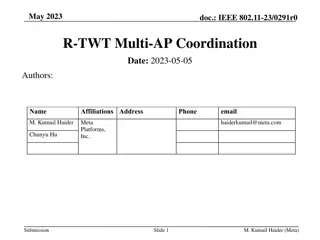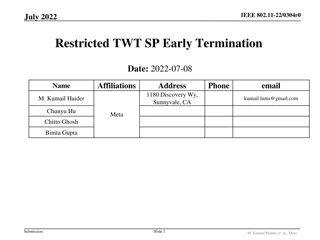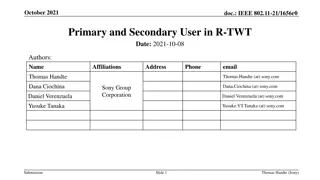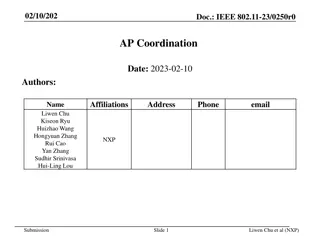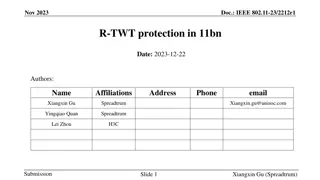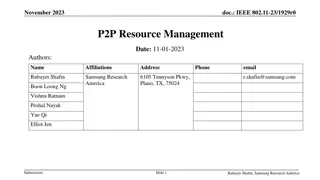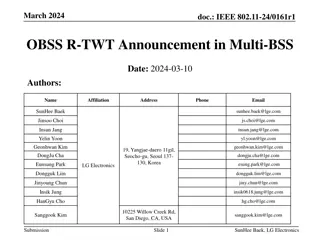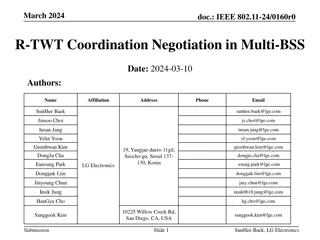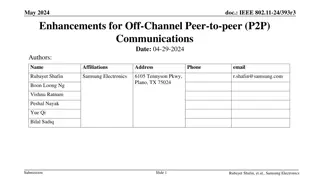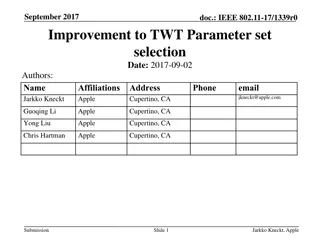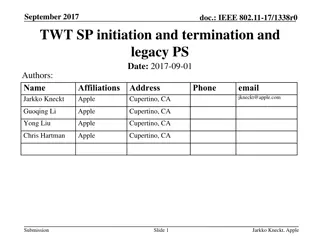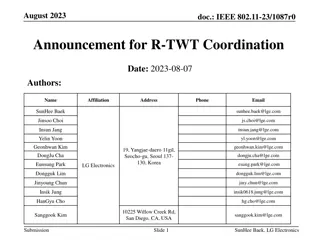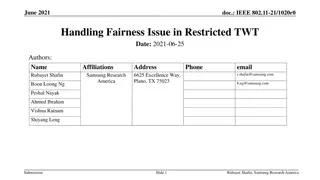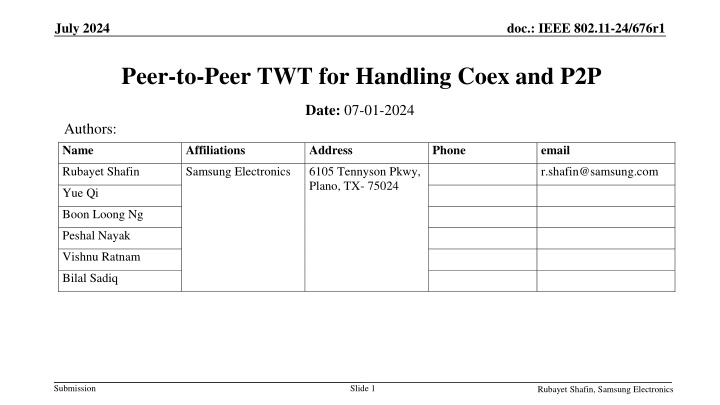
Enhancing IEEE 802.11 for WLAN Coexistence and Peer-to-Peer Communication
Explore potential enhancements to IEEE 802.11 for improved support of periodic/deterministic in-device coexistence for WLAN devices, focusing on Peer-to-Peer TWT mechanisms, scheduling, and alignment with coexistence events.
Download Presentation

Please find below an Image/Link to download the presentation.
The content on the website is provided AS IS for your information and personal use only. It may not be sold, licensed, or shared on other websites without obtaining consent from the author. If you encounter any issues during the download, it is possible that the publisher has removed the file from their server.
You are allowed to download the files provided on this website for personal or commercial use, subject to the condition that they are used lawfully. All files are the property of their respective owners.
The content on the website is provided AS IS for your information and personal use only. It may not be sold, licensed, or shared on other websites without obtaining consent from the author.
E N D
Presentation Transcript
July 2024 doc.: IEEE 802.11-24/676r1 Peer-to-Peer TWT for Handling Coex and P2P Date: 07-01-2024 Authors: Name Affiliations Address Phone email Rubayet Shafin Samsung Electronics 6105 Tennyson Pkwy, Plano, TX- 75024 r.shafin@samsung.com Yue Qi Boon Loong Ng Peshal Nayak Vishnu Ratnam Bilal Sadiq Submission Slide 1 Rubayet Shafin, Samsung Electronics
July 2024 doc.: IEEE 802.11-24/676r1 Abstract In this contribution, we provide some of the potential enhancements to 802.11 to better support periodic/deterministic in-device coexistence for WLAN devices. Submission Slide 2 Rubayet Shafin, Samsung Electronics
July 2024 doc.: IEEE 802.11-24/676r1 Introduction Coex/P2P events for a STA can be scheduled or planned ahead of time. In such cases, the coex events can occur in a periodic manner with known periodicity parameters such as coex/P2P start time, duration, and interval. During the coex/P2P events, the STA maybe unavailable for communication with some other STAs. For instance, during the coex/P2P window, a non-AP STA may not be available for infrastructure operation with the AP AP1 STA1's Unavailability window for AP1 STA1's Unavailability window for AP1 STA1's Unavailability window for AP1 STA1 Coex/P2P window between STA1 and STA2 Coex/P2P window between STA1 and STA2 Coex/P2P window between STA1 and STA2 STA2 Coex/P2P SP Coex/P2P Interval Submission Slide 3 Rubayet Shafin, Samsung Electronics
July 2024 doc.: IEEE 802.11-24/676r1 Peer-to-Peer TWT Peer-to-peer TWT was introduced in the baseline to indicate to the AP the periodic unavailability of the STA due to coex/P2P communication. The baseline channel usage procedure was extended to facilitate peer-to-peer TWT. The non-AP STA sends a Channel Usage Request frame and includes a TWT element to request to set up a peer-to-peer TWT schedule with the AP Once, a peer-to-peer TWT schedule is set up with the non-AP STA, the AP does not send any downlink frame to the non-AP STA and does not solicit uplink frame from the non-AP STA. Unavailability schedule setup Channel Usage Response frame AP1 Channel Usage Request frame (with TWT IE) Unavailability Unavailability Unavailability STA1 Submission Slide 4 Rubayet Shafin, Samsung Electronics
July 2024 doc.: IEEE 802.11-24/676r1 Need for Enhancements(1) For TWT operation--due to the lack of granularity in the TWT interval units, once the TWT has been setup, over time, it is expected that there would be a mismatch between traffic arrival time and the TWT SP start time. The divergence would increase as time progresses. Also, if the STA has a P2P link, the AP clock and the P2P group s clock may get unsynchronized over time, we may need to re-align the TWT SP start time. For Peer-to-peer TWT to handle coex events, there needs to be a mechanism to update/revise the peer-to-peer TWT SP start time so that it is aligned with the coex/P2P start time. Submission Slide 5 Rubayet Shafin, Samsung Electronics
July 2024 doc.: IEEE 802.11-24/676r1 Flexible Peer-to-peer TWT We need a mechanism to flexibly change the subsequent peer-to-peer TWT SP start time The change in the start time should compensate in difference in actual coex event start time and unavailability schedule previously set up with the AP. Previous agreement between AP1 and STA1 on the unavailability schedule of STA1 (unavailability SPs are shown) Unavailability SP 1 Unavailability SP 2 Unavailability SP 3 Unavailability SP 4 New unavailability schedule of STA1 (unavailability SPs are shown) Indication of change in unavailability SPs starting from the next SP) Unavailability SP 1 Unavailability SP 2 Unavailability SP 3 Unavailability SP 4 Submission Slide 6 Rubayet Shafin, Samsung Electronics
July 2024 doc.: IEEE 802.11-24/676r1 Flexible Peer-to-peer TWT: Example Unavailability schedule Modification Unavailability schedule setup Schedule Modification Resp. Channel Usage Response frame AP1 Unavailability SP based on previous agreement Schedule Modification Req. Channel Usage Request frame (with TWT IE) New New Unavailability SP Unavailability SP STA1 Unavailability Unavailability Shift in schedule (advancing the start time of the SPs) Submission Slide 7 Rubayet Shafin, Samsung Electronics
July 2024 doc.: IEEE 802.11-24/676r1 TWT Information Frame Usage TWT Information frame can be used to suspend or resume peer-to-peer TWT SPs or unavailability SPs. Currently supports Unavailability SP suspension/resumption Can be extended to support flexible peer-to-peer TWT Indication of arbitrary start time for Next SP Indication of the k-th SP from which the new/modified start time would take into effect. May also indicate in changes in other parameters: SP duration and interval Submission Slide 8 Rubayet Shafin, Samsung Electronics
July 2024 doc.: IEEE 802.11-24/676r1 Need for Enhancements (2) Unavailability information can be coupled with channel recommendation. This can be useful for P2P operation. Using gratuitous channel usage procedure, an AP can suggest a set of channel for P2P. But timing info is not factored in. STA indicating unavailability pattern and AP provides the most suitable channels The non-AP STA can indicate the coex/P2P unavailability schedule or peer-to-peer TWT schedule The AP may recommend/suggest the best off-channel or a set of preferred off-channels that best suited for such P2P schedule Example: The STA may have already decided the P2P group operation schedule/cadence, and now want to know the best channel to establish the P2P cadence. Serves dual purpose: unavailability indication for AP + finding best channels for P2P Can reuse/extension of existing tools: (Peer-to-peer TWT + Channel Usage element) in the Channel Usage Req/Resp. Submission Slide 9 Rubayet Shafin, Samsung Electronics
July 2024 doc.: IEEE 802.11-24/676r1 Summary Peer-to-peer TWT is important for handling coex events For effective unavailability indication using peer-to-peer TWT, it would be essential to devise a mechanism to update the start time of the subsequent SPs in a sequence of peer-to-peer TWT SPs. For effective handling of P2P related coex, unavailability timing information can be coupled with the recommendation for preferred channels. Submission Slide 10 Rubayet Shafin, Samsung Electronics
July 2024 doc.: IEEE 802.11-24/676r1 References [1] Liwen Chu, et.al., IEEE 802.11-23/1934r0, In-device interference mitigation follow up . [2] Alfred Asterjadhi, et.al., IEEE 802.11-23/1964r0, Coexistence Protocols for UHR . [3] Laurent Cariou, et.al., IEEE 802.11-23/2002r1, In-device coexistence and interference follow up . [4] Brian Hart, et.al., IEEE 802.11-23/2026r0, Balanced In-Device Coexistence . [5] Rubayet Shafin, et.al., IEEE 802.11-24/509r1, Thoughts on in-device coexistence and P2P for 11bn Submission Slide 11 Rubayet Shafin, Samsung Electronics





